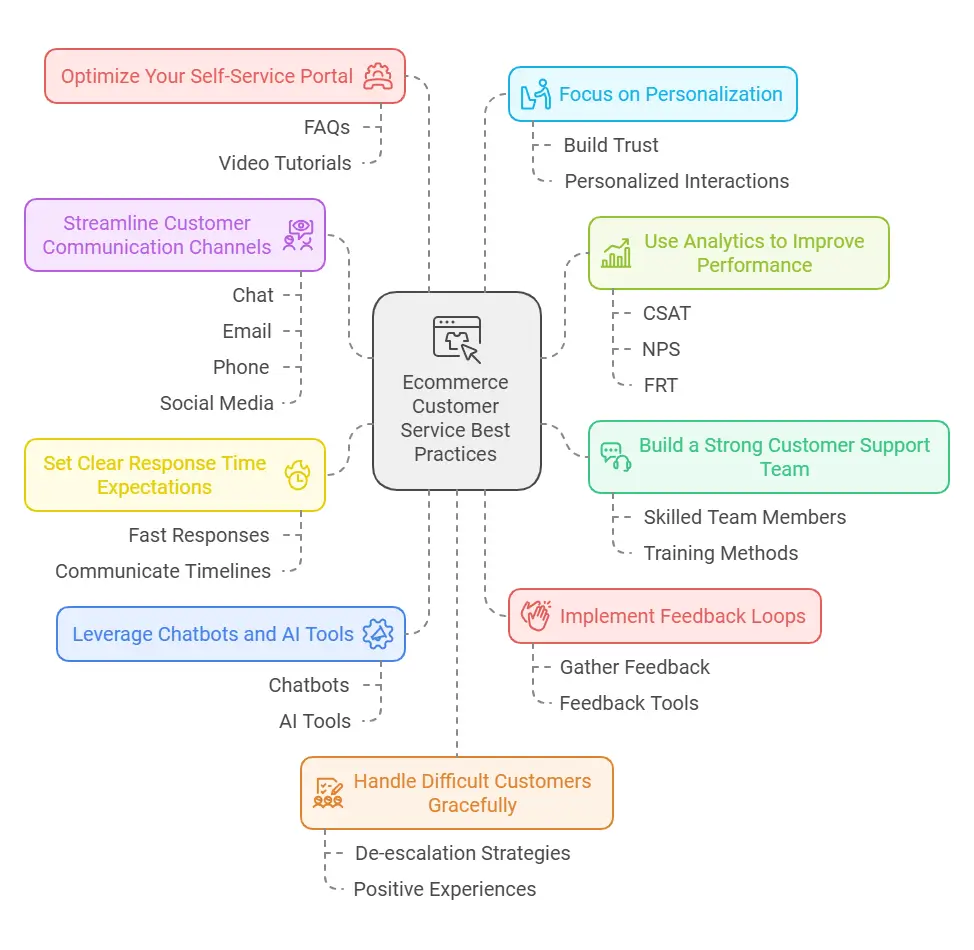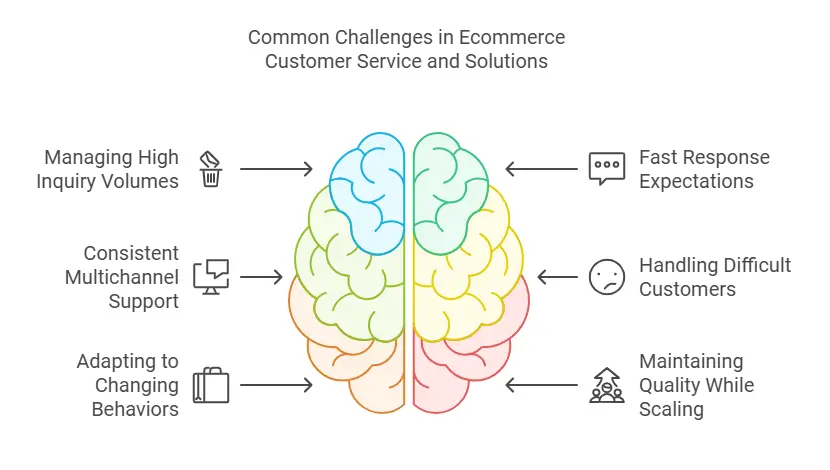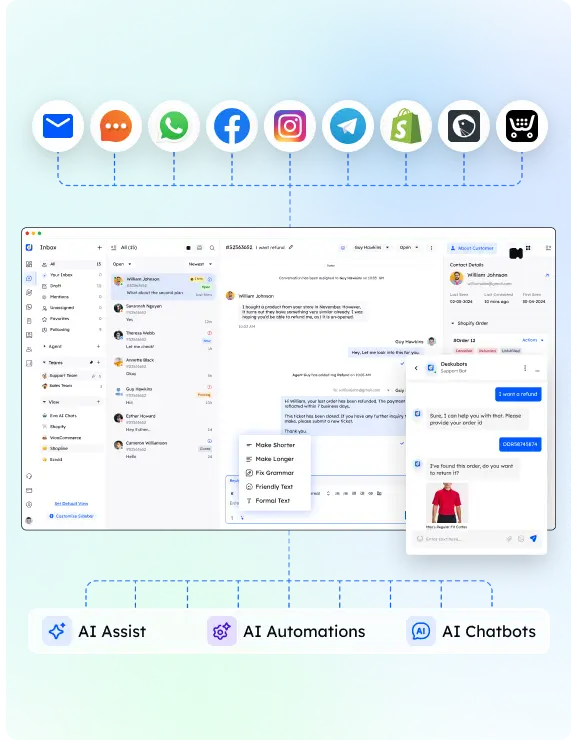Providing excellent customer service is essential for ecommerce businesses aiming to thrive in a competitive market. Ecommerce customer service isn’t just about solving customer inquiries; it’s about creating experiences that lead to Client approval and build Customer Commitment. Whether you’re running a small online store or managing a large ecommerce business, following the right practices ensures you meet and exceed customer expectations.
This post dives into 11 ecommerce customer service best practices that can help you deliver a positive customer experience, enhance customer retention, and attract more customers. We’ll explore everything from using help desk software to adopting a customer service strategy that builds loyal customers.
Let’s get started by uncovering how your customer service team can deliver good ecommerce customer service and transform online shoppers into lifelong advocates.
Top 11 Ecommerce Customer Service Best Practices

1. Build a Strong Customer Support Team
A strong customer support team forms the backbone of Outstanding ecommerce support. Your support agents are the first point of contact for addressing Customer requests and providing great customer service that fosters Customer Devotion. Investing in skilled customer service representatives ensures that your team can handle diverse Client conversation with professionalism and empathy.
Key Steps to Build a Reliable Team:
- Hire the Right Talent: Look for candidates with excellent communication skills, problem-solving abilities, and a customer-focused mindset.
- Train Regularly: Provide training on your customer service tools, such as help desk software and Online chat help platforms, to equip your team with the skills to manage customer queries efficiently.
- Encourage Collaboration: A cohesive support team works together to resolve issues faster and ensures consistent messaging across support channels.
Empowering Your Team with Tools and Technology
Equip your team with the right resources to improve productivity and provide good customer service. Modern customer service software offers features like centralized dashboards for tracking Client Metrics, automating responses, and analyzing user behavior. This not only helps support agents Supporting buyers but also improves the overall customer service experience.
Why a Strong Team Matters
A well-prepared team ensures that your ecommerce customer service aligns with customer needs. When online shoppers feel heard and valued, they’re more likely to become loyal customers, boosting User Retention for your ecommerce business.
2. Streamline Customer Communication Channels
Managing multiple Customer dialogues channels effectively is key to delivering Exceptional online customer care. Customers interact with brands through various platforms like email, chat, social media, and phone calls, and they expect a seamless experience across all these touchpoints.
Importance of Multichannel Support
- Meet Clients Where They Are: Whether through Chat-based customer service, social media DMs, or phone support, being accessible improves Consumer happiness.
- Ensure Consistency: Maintaining the same message across channels builds trust and reduces confusion.
- Handle Customer Queries Faster: Organized communication channels help your customer support team respond to inquiries promptly, boosting positive customer experience.
Best Practices for Streamlining Channels
- Centralize Communication with Tools: Use Customer support tool or customer service tools to manage all interactions in one place. Centralization helps your support agents handle high volumes of inquiries without losing track.
- Offer Multichannel Support: Integrate platforms like live chat, email, and social media with your customer service system. This approach caters to diverse customer preferences and improves Digital help center Digital help center accessibility.
- Track Customer Journeys: Understand where customer interactions happen most frequently and optimize those channels for quicker responses.
Benefits of a Streamlined Approach
Providing organized and efficient Buyer correspondence enhances the overall customer service experience. Your ability to handle inquiries across multiple channels fosters customer loyalty and ensures online businesses maintain strong relationships with satisfied consumers.
3. Set Clear Response Time Expectations
One of the hallmarks of good ecommerce customer service is how quickly and accurately your support team addresses Client issues. In the world of online shopping, customers expect fast responses. Failing to meet these expectations can harm your brand’s reputation and reduce Buyer fulfillment.
Why Response Time Matters
- Meets Customer Expectations: Quick replies show customers that you value their time.
- Reduces Frustration: Long waits for assistance often lead to dissatisfied customers and lower User Retention.
- Enhances Brand Trust: Providing prompt support builds trust, encouraging online shoppers to return.
How to Set and Maintain Response Time Goals
- Define Response Time Standards: Communicate clear timelines for different support channels like email, phone support, and Instant messaging support. For instance:
- Respond to live chat inquiries within 1-2 minutes.
- Answer emails within 12-24 hours.
- Use Automation to Stay Ahead: AI-powered chatbots can provide instant responses to common customer queries, ensuring your team focuses on complex issues.
- Monitor Performance: Use customer service software to track metrics like First Response Time (FRT) and Resolution Time. This helps you identify areas for improvement.
Benefits of Clear Expectations
When customers know how soon they’ll hear back, their patience improves, and they’re more likely to experience a positive customer experience. This transparency creates Faithful clients and showcases your commitment to providing First-rate ecommerce assistance.
4. Leverage Chatbots and AI Tools
AI tools and chatbots are transforming ecommerce customer service by providing instant solutions to Buyer queries and streamlining processes for Customer Care Agents. Integrating these technologies ensures that ecommerce businesses deliver great customer service while saving time and resources.
Benefits of Using Chatbots and AI
- Instant Responses: Chatbots can handle repetitive questions, offering quick answers and reducing wait times. This keeps online shoppers engaged and enhances their customer service experience.
- 24/7 Availability: Unlike human agents, AI tools work round the clock to Customer assistance expect assistance at any time.
- Personalized Interactions: AI systems can analyze Consumer Insights to offer tailored solutions, creating a more personal connection and driving Brand Affinity.
Examples of AI Tools in Customer Service
- Live Chat Support Platforms: Automate answers to FAQs while allowing seamless handoffs to human agents for complex queries.
- Sentiment Analysis Tools: Monitor customer behavior during interactions to identify frustrations and adjust responses accordingly.
- CRM Integrations: AI-powered CRM tools analyze Purchase process to help customer service teams anticipate needs and improve interactions.
Best Practices for Implementing AI
- Choose the Right Platform: Look for Helpdesk solution or chatbot solutions that integrate smoothly with your existing customer service tools.
- Blend AI with Human Support: While chatbots can handle basic inquiries, ensure that Assistance Professionals are available for more complex issues.
- Train AI Models: Regularly update your chatbot’s knowledge base with relevant information to keep responses accurate.
Why AI and Chatbots Matter
By leveraging AI, you improve efficiency, meet customer expectations, and maintain high levels of customer satisfaction. This hybrid approach enables online businesses to provide good ecommerce customer service and foster Consumer Retention.
5. Optimize Your Self-Service Portal
Providing self-service options is one of the most effective ways to empower customers and deliver Superior digital service for customers. A well-designed online self-service portal allows customers to resolve issues on their own, saving time for both your Support Desk Staff and the customer.
Key Components of a Self-Service Portal
- Comprehensive FAQ Section: Include answers to common Client questions about orders, returns, and product details.
- Knowledge Base: Offer guides, tutorials, and articles that address more detailed topics or processes.
- Search Functionality: Ensure customers can quickly find what they need by searching for specific terms or keywords.
- Chatbots for Assistance: Enhance the portal with chatbots to guide customers when they need extra help.
Benefits of Self-Service Options
- Improves Customer Satisfaction: Many customers prefer resolving issues independently rather than waiting for a response from Helpdesk Representatives.
- Reduces Support Workload: Your customer service team can focus on more complex Client inquiries when simple issues are handled through the portal.
- Increases Accessibility: With 24/7 availability, customers can get the help they need anytime, enhancing their customer experience.
Best Practices for Optimizing Self-Service Portals
- Keep Content Updated: Regularly review and update information to ensure it remains accurate and relevant to customer needs.
- Use Analytics to Improve: Monitor which resources are most used and identify gaps in your content.
- Make It User-Friendly: Ensure the portal is mobile-friendly and easy to navigate, as many online shoppers access it from smartphones.
Impact of Self-Service on Ecommerce
A robust self-service portal enhances the overall Consumer path, ensuring online stores provide the convenience that today’s customers expect. It also contributes to creating loyal customers by offering a smooth, hassle-free experience.
6. Focus on Personalization
Personalizing customer interactions can make a significant impact on customer satisfaction and Brand Affinity. Modern ecommerce businesses can use User Data to offer tailored experiences that resonate with individual needs.
Why Personalization Matters
- Builds Trust: Personal touches make customers feel valued and appreciated.
- Improves Retention: Customers are more likely to stay loyal when they receive relevant and customized solutions.
- Enhances Positive Feedback: Personalization encourages customers to share their great experiences.
Strategies for Personalizing Customer Service
- Leverage Customer Data: Use data from previous purchases, browsing behavior, and customer feedback to tailor support.
- Segment Your Audience: Divide customers into groups based on their preferences, behavior, or needs, and offer targeted solutions.
- Train Your Team: Equip your customer service agents to address customers by name and reference past interactions for a seamless experience.
Personalization isn’t just a nice-to-have—it’s a critical part of Exceptional online customer care that leads to loyal customers and long-term growth.
7. Handle Difficult Customers Gracefully
Not every interaction will be smooth, but knowing how to manage challenging situations is key to delivering good customer service. Handling tough cases effectively can turn unhappy customers into advocates.
Tips for Managing Difficult Customers
- Stay Calm and Empathetic: Show understanding and acknowledge their concerns.
- Focus on Solutions: Quickly identify what the customer needs and offer actionable resolutions.
- Empower Agents: Give your Customer Care Agents the authority to make decisions that resolve issues swiftly.
Graceful handling of tough situations reflects a solid customer service approach and builds a reputation for great customer service.
8. Ensure Proactive Customer Support
Proactive support involves addressing potential issues before customers bring them up. This can improve the Client assistance interaction and enhance Client Retention.
Ways to Be Proactive
- Send Order Updates: Keep customers informed about shipping and delivery.
- Notify About Policy Changes: Alert customers about updates to return policies or warranties.
- Reach Out for Feedback: After resolving a query, follow up to ensure the customer is satisfied.
Proactive communication demonstrates that your customer service team is committed to Helping shoppers beyond the basics.
9. Use Customer Feedback to Improve
Feedback is a goldmine for insights into improving your customer service strategy. Listening to customers shows you care and helps you identify areas for growth.
How to Gather Feedback
- Surveys and Reviews: Use email surveys or encourage customers to leave reviews.
- Monitor Social Media: Keep an eye on customer mentions and comments.
- Ask Directly: Train your Client Support Staff to request feedback after resolving issues.
Benefits of Leveraging Feedback
Using feedback helps you deliver excellent ecommerce customer service by identifying trends, addressing recurring issues, and enhancing the overall Buyer lifecycle.
10. Empower Your Team with the Right Tools
Your Client Care Team can’t excel without the right customer Service Resources. These tools simplify processes and ensure your team can provide timely, efficient support.
Must-Have Tools for Ecommerce Support
- Assistance software: Centralizes customer queries for better management.
- Live Chat Platforms: Facilitates instant communication with online shoppers.
- CRM Tools: Tracks Client Information and helps personalize interactions.
Investing in technology not only supports your team but also ensures satisfied customers.
11. Monitor and Analyze Performance
To maintain excellent ecommerce customer service, continuously evaluate your team’s performance using metrics like:
- CSAT (Customer Satisfaction Score)
- NPS (Net Promoter Score)
- First Response Time (FRT)
Use these insights to refine your customer service approach and meet evolving Consumer demands.
Common Challenges in Ecommerce Customer Service and Solutions

Running ecommerce customer service comes with its own set of challenges. Addressing these hurdles effectively can improve customer satisfaction, boost brand loyalty, and Build customer loyalty. Here are some common challenges and practical solutions to overcome them.
1. Managing High Volumes of Customer Inquiries
The Challenge: During peak seasons like holidays or sales, online stores often face a surge in customer queries, leading to longer response times and overwhelmed support teams.
The Solution:
- Use help desk software to organize and prioritize inquiries.
- Implement AI-powered chatbots for instant responses to FAQs, allowing your team to focus on more complex issues.
- Train your customer service agents to handle queries efficiently without compromising quality.
2. Meeting Customer Expectations for Fast Responses
The Challenge: Customers expect prompt responses, especially with channels like Online chat help and phone support. Failing to meet these expectations can harm your reputation.
The Solution:
- Set clear response time goals for all communication channels.
- Use automation tools to acknowledge and queue queries instantly.
- Monitor response times using Service Management Tools and optimize processes to improve speed.
3. Providing Consistent Multichannel Support
The Challenge: Ensuring consistency across email, chat, social media, and phone can be tricky, especially with multiple agents handling similar issues.
The Solution:
- Centralize all Shopper interactions through a unified platform.
- Standardize responses with templates and workflows while maintaining a personalized tone.
- Regularly train your Customer Care Agents on handling multichannel queries.
4. Handling Difficult or Unhappy Customers
The Challenge: Negative experiences can lead to poor reviews and lost business if not managed well.
The Solution:
- Empower agents to resolve issues without excessive escalation.
- Train your support team to stay calm, listen actively, and focus on solutions.
- Follow up with dissatisfied customers to ensure their concerns are fully resolved.
5. Adapting to Rapidly Changing Customer Behavior
The Challenge: With evolving online shopping trends, Shoppers anticipate personalized and seamless experiences.
The Solution:
- Leverage customer data to track behavior and preferences.
- Invest in analytics tools to identify trends and adjust your customer service strategy.
- Use customer feedback to refine your processes and adapt to changing expectations.
6. Maintaining Quality While Scaling
The Challenge: As your ecommerce business grows, maintaining the same level of excellent customer service becomes harder.
The Solution:
- Invest in scalable tools like CRMs and help desk software.
- Regularly evaluate team performance and processes to ensure scalability.
- Hire and train new agents proactively to avoid overburdening your existing support team.
By addressing these challenges head-on, ecommerce businesses can ensure great customer service, improve the customer journey, and build stronger relationships with satisfied customers.
FAQ: Ecommerce Customer Service Best Practices
1. What is ecommerce customer service?
Ecommerce customer service refers to the support provided by online businesses to assist customers during their shopping journey. This includes resolving issues, answering customer inquiries, and ensuring a smooth buying experience.
2. Why is customer service important in ecommerce?
Customer service plays a vital role in building customer loyalty, improving customer satisfaction, and ensuring customer retention. Providing excellent customer service encourages repeat purchases and fosters trust with online shoppers.
3. What are the key tools for ecommerce customer support?
Essential tools include:
Help desk software for managing queries.
Live chat support for instant responses.
CRM tools to track and analyze customer data.
These tools streamline operations and improve the Customer support journey.
4. How can I handle customer inquiries across multiple channels?
Use multichannel customer support systems that centralize communication from email, chat, social media, and phone support. This ensures consistent and efficient responses across all support channels.
5. How do self-service options improve customer experience?
An online self-service portal with FAQs, tutorials, and chatbots allows customers to resolve issues independently. This reduces workload on your customer service agents and increases customer satisfaction.
6. How does personalization enhance ecommerce customer service?
By using customer data to tailor customer interactions, businesses can offer more relevant solutions. This creates a positive customer experience and helps build brand loyalty.
Conclusion
Implementing these ecommerce customer service best practices will help you provide good ecommerce customer service and Cultivate devoted customers. From empowering your customer support team with the right tools to leveraging customer feedback, every step contributes to a smoother customer journey and improved customer retention.


